
All About Japan's Famous Weeping Cherry Trees: Seasons, Types, and Where to See Them
- Written by: WESTPLAN
Japan is full of famous places where you can see sakura, or cherry blossom trees. One of the cherry blossom trees that stands out the most is called the "Shidarezakura", or "weeping cherry tree", which has many flowers blooming on drooping branches.
There are many types of weeping cherry trees, and each one boasts its own unique beauty. Also, there are many famous places sporting this sakura variety. Find out where they are and when they're in full bloom so you can see them, too!
1. What are the Characteristics of Weeping Cherry Blossom Trees?
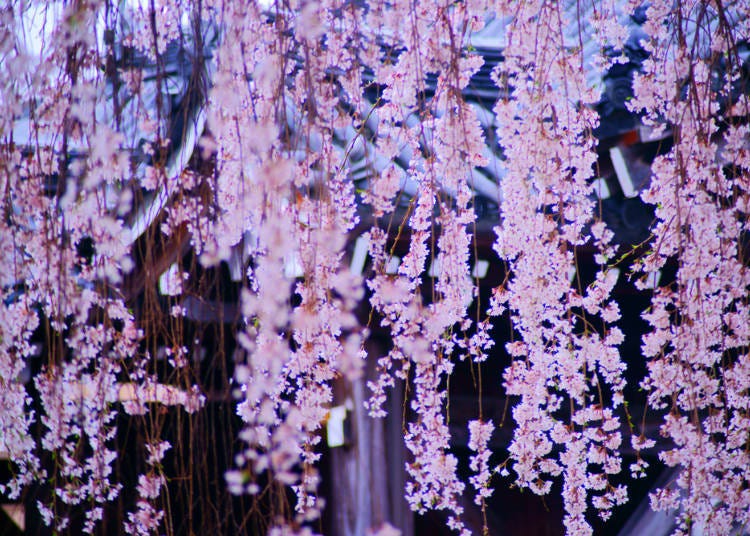
Weeping cherry blossom trees (しだれ桜) are characterized by their thin, drooping branches that hang down like threads, also earning them the nickname "itozakura" (thread cherry blossoms). These popular trees have a long history dating back as far as the Heian Period 1200 years ago.
It is actually a mutation that causes the branches to sag. Not all weeping cherry trees weep. These trees also have very long lifespans. One famous old sakura tree in Fukushima Prefecture, called the Miharu Takizakura, is said to be over 1000 years old!
The color of the flowers depends on the type of weeping cherry tree, and can vary between pink, white, and red.
2. Flowering Times and Best Times to See Weeping Cherry Blossoms
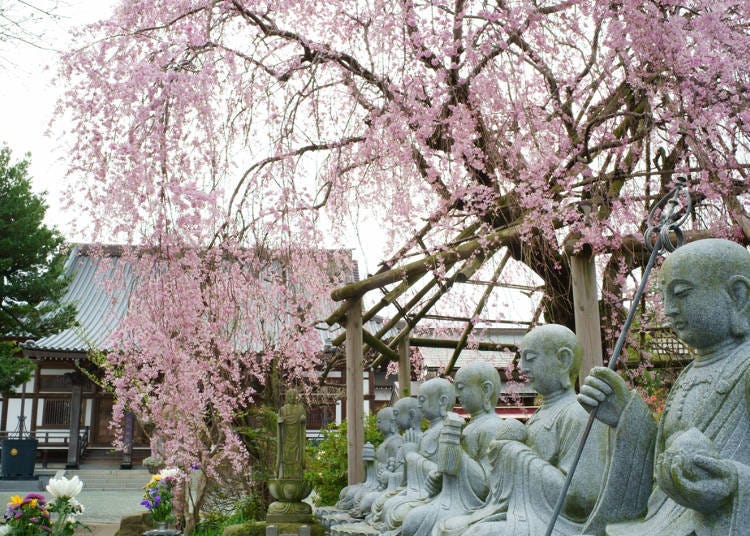
Though times vary by region, weeping cherry trees usually bloom around late March and reach full bloom in April. Compared to the Somei-Yoshino cherry tree, some bloom about a week earlier, and some bloom later.
3. Types of Weeping Cherry Blossom Trees
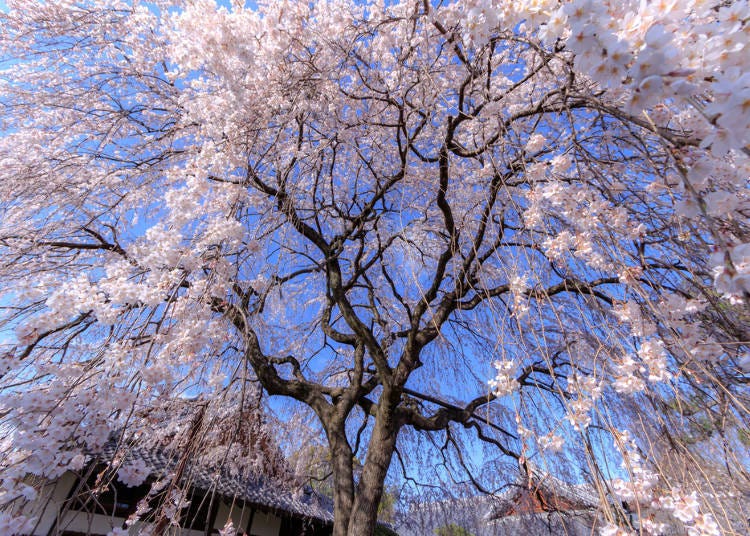
"Shidarezakura," or "weeping cherry tree," is the general term for cherry blossom trees with sagging branches. Here are some variations.
i. Yae-Beni-Shidare (八重紅枝垂)
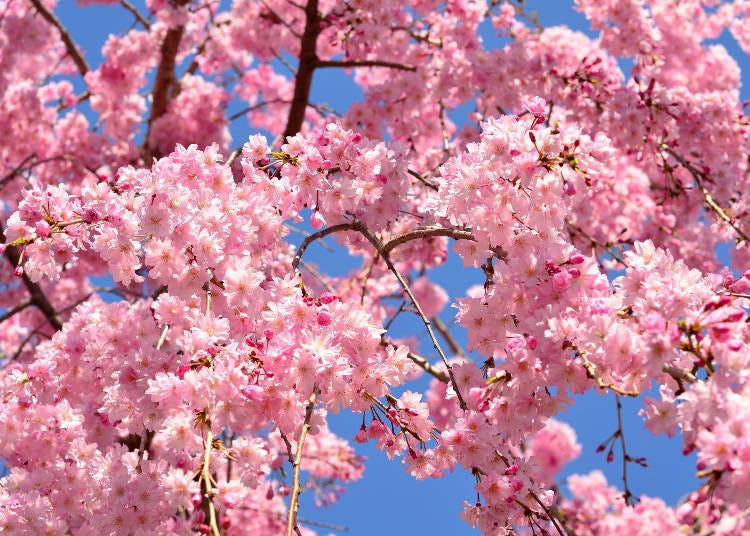
This cherry blossom tree is one type of the Edo-higan variety. The leaves appear more volumi-nous due to the double-flowered crimson cherry blossoms, which make it stand out even from a distance. Because the former mayor of Sendai City, Yoji Endo, made efforts to popularize this tree, it has also earned other nicknames such as Endo Sakura, Sendai Yaeedari, and Sen-dai Kozakura. It has also been called the Heian Beni-shidare, named after the Yae-Beni-Shidare tree in Kyoto's Heian Shrine.
ii. Kiyosumi-Shidare (清澄枝垂)
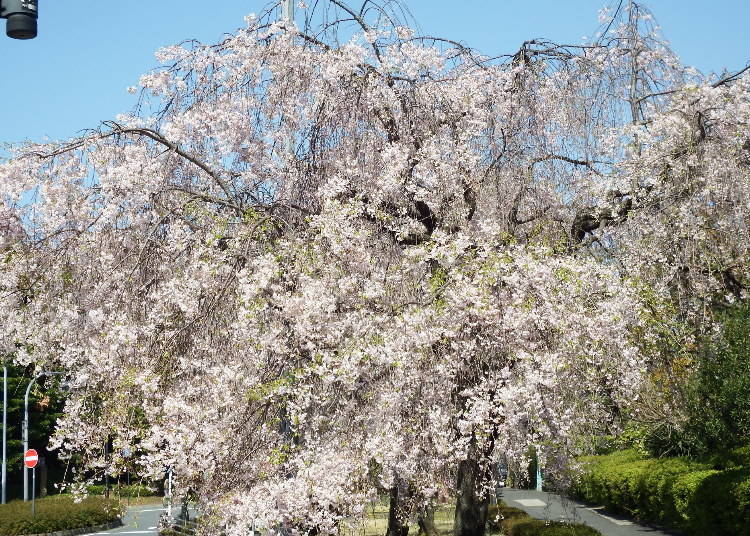
This variety of winter cherry blossom blooms white, single flowers in mid-April. It was named after the ancient trees at Seichoji Temple in Kamogawa City, Chiba Prefecture. They are also known as "shidare-kobazakura," or weeping leaf cherry tree.
iii. Benishidare (紅枝垂)
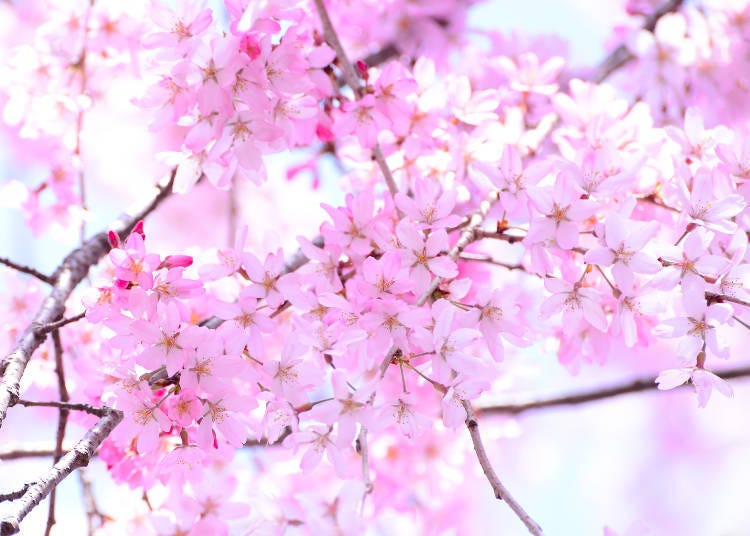
Just like the Yae-Beni-Shidare, this is another type of Edo-higan tree. It has single flowers, and the same deep crimson color.
iv. Shidare-Yamazakura (枝垂山桜)
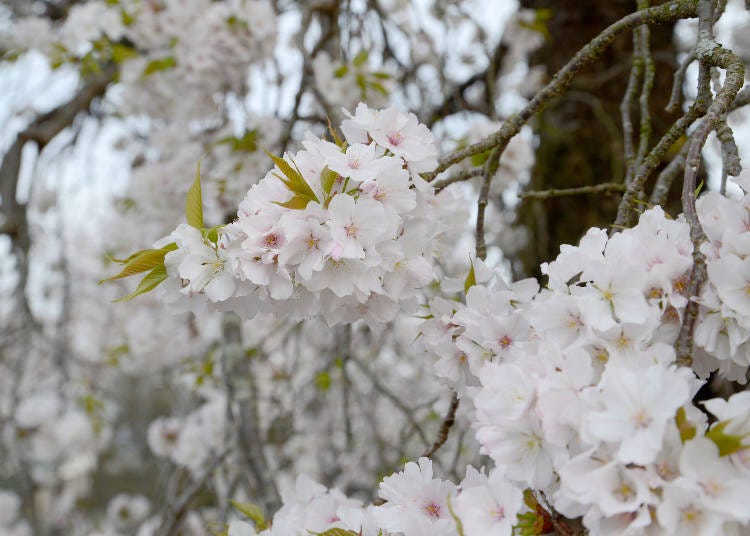
This is a type of yamazakura, or wild cherry tree, with pale pink, single flowers and a notch at the tip of the petals.
v. Yoshino-Shidare (吉野枝垂)
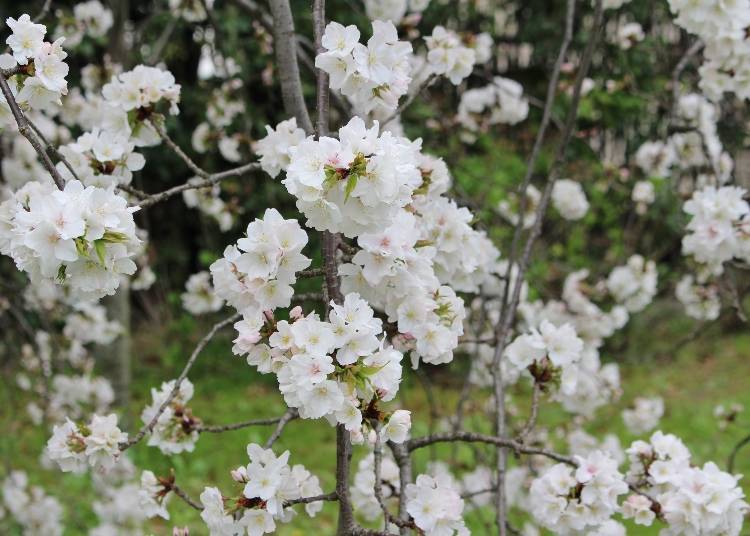
This is a variety of Somei-Yoshino cherry tree with hanging branches. Like the typical Somei-Yoshino cherry tree, it is characterized by many pale crimson, single flowers.
vi. Ito-Shidare (糸枝垂)
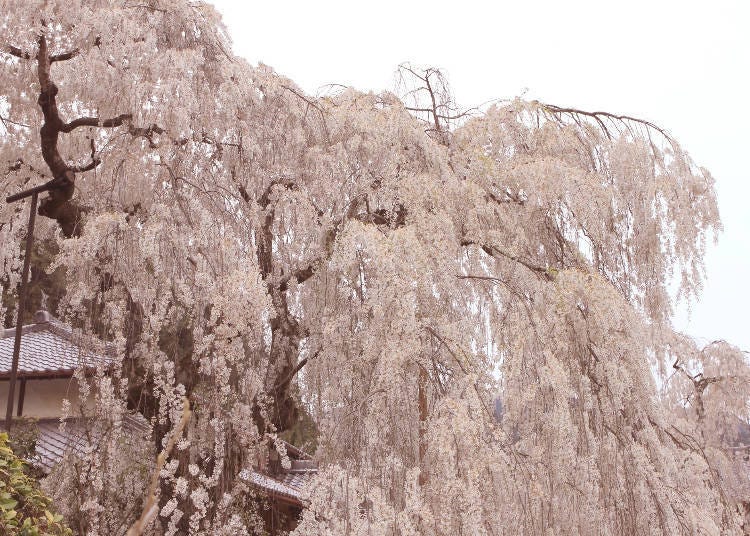
This weeping cherry tree grows rather large, and bloom light pink double flowers. One large, particularly famous tree at Onodera Temple in Uda City, Nara Prefecture is said to be 300 years old!
4. Weeping Cherry Blossoms FAQs
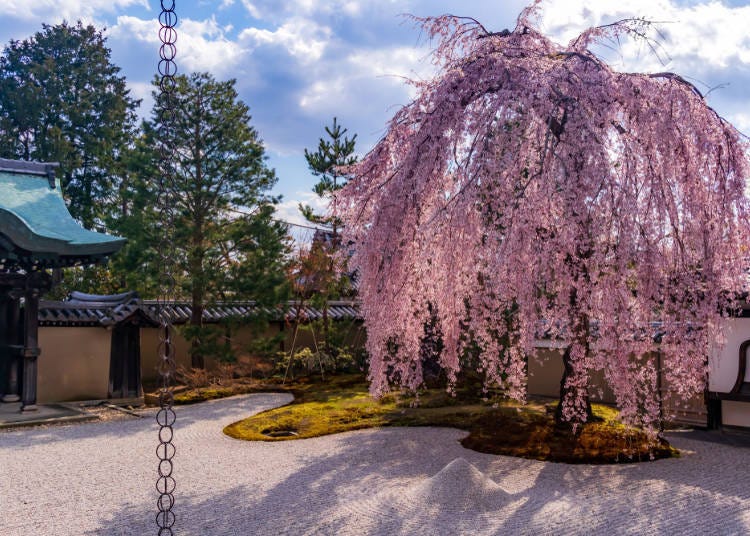
Learn even more about weeping cherry blossom trees! Frequently asked questions.
Q1: Can weeping cherry blossoms be found all around Japan?
They can be found in various places from Hokkaido to Kyushu. You'll also find Yoshino trees planted along roads and in parks in a number of places.
However, if you're looking for a spot where you can see lots of them planted together, you may have to travel a bit further.
The overwhelming beauty of the full-bloom cherry tree has often been the subject of novels and plays, and is said to be "magical."
Q2: How many years do they live?
The Somei-Yoshino cherry tree is said to have a lifespan of 70 to 80 years. However, many weeping cherry trees have a much longer lifespan of 300 years or more. They also grow very tall, and many have been designated as natural monuments.
Q3: How tall can the weeping cherry tree grow?
Weeping cherry trees grow best in a well-ventilated environment with sunlight and good drainage. Depending on the variety, they generally reach about 5 to 10 meters tall, though some grow even taller as they age.
Q4: Can you grow weeping cherry trees as bonsai?
Weeping cherry trees are grown from seeds, so you can also grow them as bonsai. However, they rarely germinate, if at all, and if they do, it may take many years for the flower to bloom.
However, seedlings are commercially available, and you can enjoy growing them in the shape and size of your choosing.
Q5: Can you find them in Japanese gardens?
You can sometimes find strong, beautiful weeping cherry trees planted in Japanese gardens. Weeping cherry blossoms, with their flowery branches drooping all around the trunk, look even more fantastic when lit up!
In the olden days, superstition said that weeping cherry blossom and plum trees would bring bad luck to the home, so people avoided planting them in their garden.
However, in recent years, people's perspective on the value they bring to the landscape has changed.
5. Five Famous Weeping Cherry Blossom Spots in Japan
Here are some recommended sightseeing spots to see the famous weeping cherry blossoms all over Japan. Grab some friends and check them out!
i. Miharu Takizakura (Fukushima Prefecture)
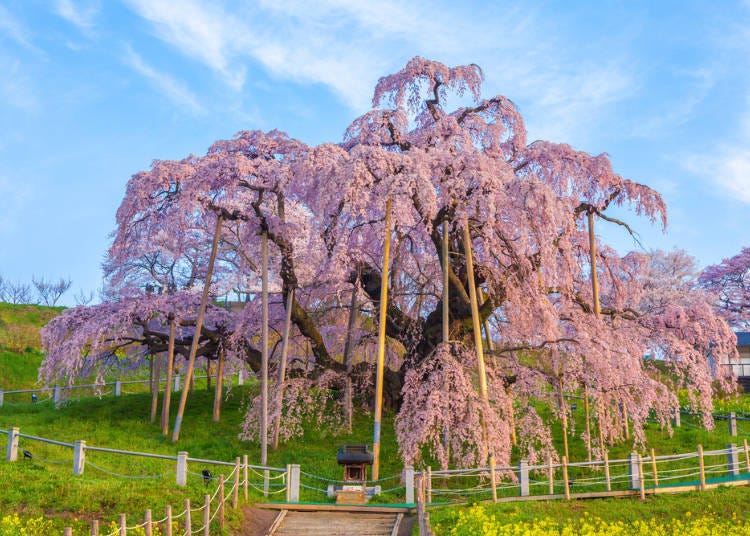
Neoya Usuzumi Zakura (Motosu City, Gifu Prefecture) and Yamataka Jindai Zakura (Hokuto City, Yamanashi Prefecture) are two of Japan's three most famous cherry blossom trees, estimated to be nearly 1000 years old! They are designated natural monuments. Countless small pink flowers bloom on branches that extend outward in all directions from the 13.5-meter tall trunk.
・Best time to see: Mid-April
-

-
Address
Sakurakubo, Taki, Miharu-machi, Tamura-gun, Fukushima, 963-7714
View Map -
Nearest Station
Miharu Station (Ban-etsuto Line)
15 minutes by bus
- Phone Number 0247-62-3690
-
Address
Sakurakubo, Taki, Miharu-machi, Tamura-gun, Fukushima, 963-7714
Nearby Sightseeing Spot
BRITOMART
(348-4 Niimichi Saito, Miharu-cho, Tamura-gun, Fukushima Prefecture)
A facility with restaurants, bakeries, sweets, coffee, interior shops, flowers & exteriors, flowers & greens, and local food shops.
ii. Weeping Cherry Trees in Kakunodate Samurai District (Akita Prefecture)
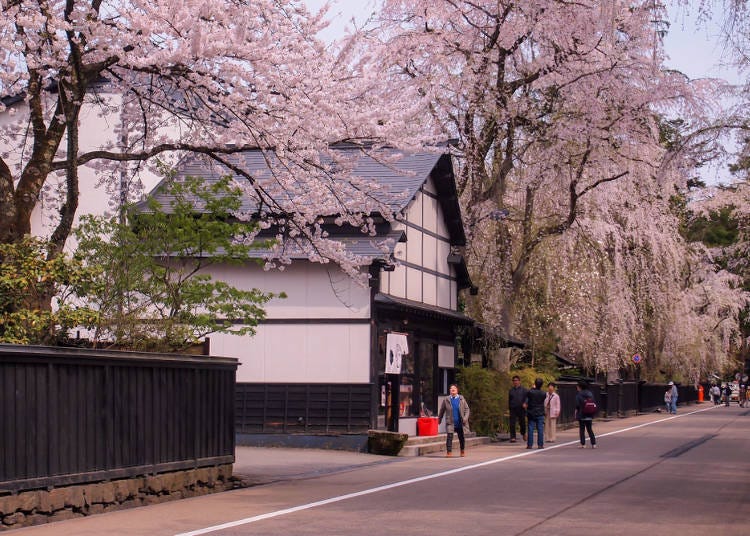
Around 1656, weeping cherry trees were planted at each home along the Samurai District's Bukeyashiki Street in Kakunodate, Akita Prefecture.
Some tree trunks reach a circumference of more than 1 meter around, and some trees grow over 20 meters tall.
The pink flowers of the weeping cherry blossoms stand out against the blackboard walls of Bukeyashiki Street, creating a picture-perfect landscape.
More than 90% of these cherry blossom trees are of the Edo-higan variety, and 162 of the 450 weeping cherry trees are designated as natural monuments.
・Best time to see: Mid-April to early May
-

-
Address
Omotemachikamicho, Kakunodatemachi, Senboku-shi, Akita, 014-0334
View Map -
Nearest Station
Kakunodate Station (Tazawako Line / Akita Shinkansen / Akita Nairiku Line)
20 minutes on foot
- Phone Number 0187-54-2700
-
Address
Omotemachikamicho, Kakunodatemachi, Senboku-shi, Akita, 014-0334
Nearby Sightseeing Spot
Bukeyashiki Ishiguro-ke
This is the oldest surviving samurai residence, with a thatched-roof main house. In the garden, there are artificial hills, huge stones, large fir trees, and a gazebo. The residence is surrounded by a blackboard wall with a peephole. Though simple in appearance, it retains its true samurai style.
-

-
Address
1 Shimocho, Kakunodatemachi, Semboku City, Akita Prefecture, 014-0331
View Map -
Nearest Station
Kakunodate Station (Tazawako Line / Akita Shinkansen / Akita Nairiku Line)
5 minutes by car
- Phone Number 0187-55-1496
-
Address
1 Shimocho, Kakunodatemachi, Semboku City, Akita Prefecture, 014-0331
iii. Nicchusen Weeping Cherry Blossom Trees (Fukushima Prefecture)
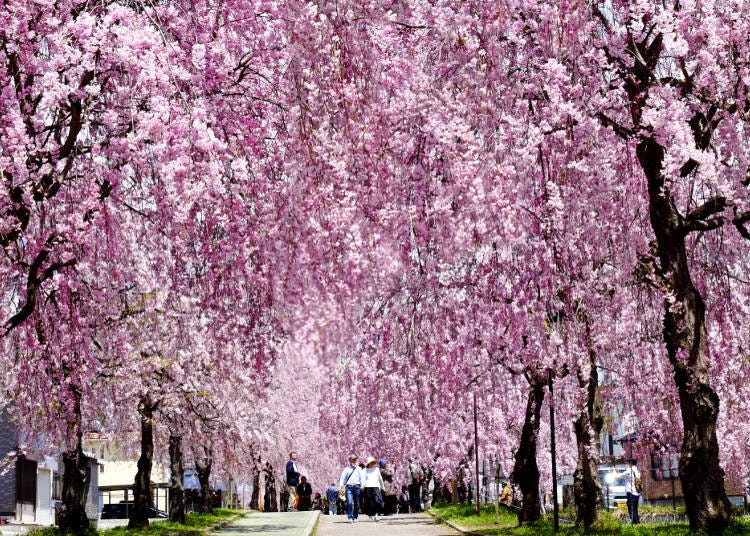
Once the site of the former Nicchu Line, discontinued in 1984, a portion of the area has been made into a 3km promenade with nearly 1,000 weeping cherry trees. You can see an exhibit of the steam locomotive that once ran here at the mid-point. It's a great spot for cherry blossom photos. There is also a magnificent tunnel of weeping cherry trees that wows visitors every time!
・Best time to see: Mid-April to late April
-
Nicchusen Weeping Cherry Tree日中線しだれ桜並木
- Address 22 Suwa, Kitakata City, Fukushima 966-0095
-
Nearest Station
About a 20-minute walk from JR Banetsu West Line Kitakata Station
Tel: 0241-24-5200 (Kita Tourist Products Association) Weekdays 8:30 - 17:00
Nearby Sightseeing Spot
Kitakata Kura no Sato
(2-109, Oshikiri, Kitakata City, Fukushima Prefecture)
Kitakata City prospered as a supply distribution center during the Edo Period. Over 4,200 warehouses still remain. Nine of these buildings have been relocated to Kitakata Kura no Sato to preserve the nostalgic city scenery, including shops, a miso warehouse, a granary, and old residences.
iv. Rikugien Gardens (Tokyo)
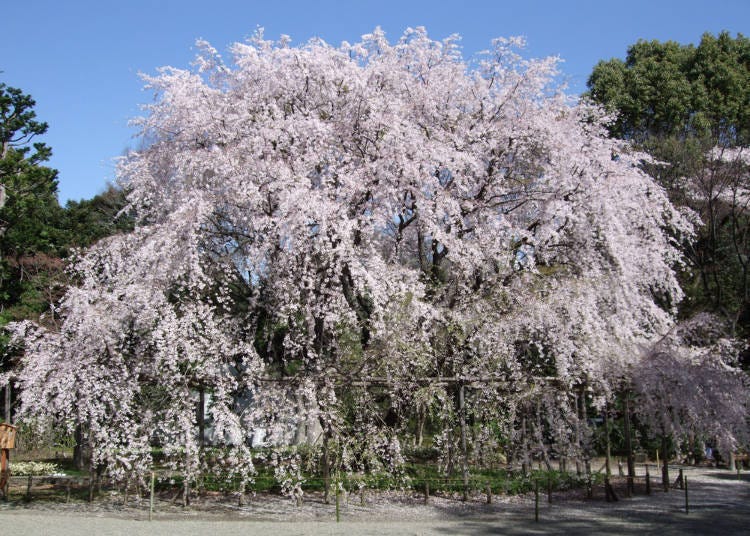
Rikugien Gardens was said to be one of the two largest gardens in Edo, along with Koishikawa Korakuen Garden. There are 75 weeping cherry trees in the park, including Yoshino, Yama-zakura, and Satozakura cherry trees. The largest weeping cherry tree is 70 years old and stands about 15 meters tall. Many flowers bloom on 20-meter-long branches that droop down like a cherry blossom waterfall.
・Best time to see: late March
-

-
Address
6, Honkomagome, Bunkyo-ku, Tokyo, 113-0021
View Map -
Nearest Station
Komagome Station (JR Yamanote Line / Tokyo Metro Namboku Line)
7 minutes on foot
- Phone Number 03-3941-2222
-
Address
6, Honkomagome, Bunkyo-ku, Tokyo, 113-0021
Nearby Sightseeing Spot
Kyu-Furukawa Gardens
This park retains elements of the gardens of the early Taisho Period, with a Western-style building on a small hill, a Western-style garden along the slope, and a Japanese garden on the lowlands. This harmonious combination of Japanese and Western beauty has been designated as a national scenic spot. It is famous for the rose garden left by the Furukawa Zaibatsu group.
-

-
Address
1-27-39, Nishigahara, Kita-ku, Tokyo, 114-0024
View Map -
Nearest Station
Kami-Nakazato Station (JR Keihin-Tohoku Line)
7 minutes on foot
- Phone Number 03-3910-0394
-
Address
1-27-39, Nishigahara, Kita-ku, Tokyo, 114-0024
v. Sekiba Weeping Cherry Tree (Tochigi Prefecture)
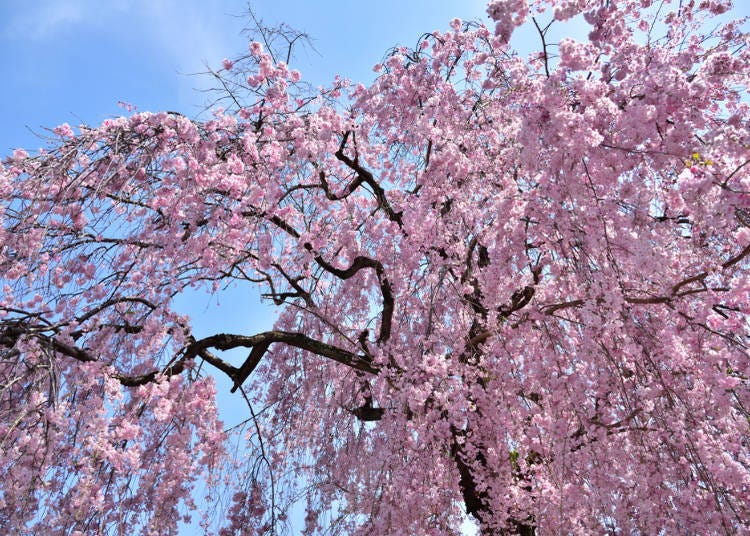
This single cherry tree stands 20 meters tall, branching out 20 meters east-west, and 28 meters north-south. This beautiful weeping cherry tree is over 350 years old, and was designated as a natural monument in 1962.
・Best time to see: Early to late April
-
Sekiba Weeping Cherry Tree関場の枝垂桜
- Address 771 Akiyamacho, Sano-shi, Tochigi 327-0157
-
Nearest Station
About 25 minutes by car from the Sano-Tanuma IC on the Kita-Kanto Expressway
Tel: 028-21-5111 (Sano City Tourism Association 9:00-18:00/open daily)
Nearby Sightseeing Spot
Domannaka Tanuma Rest Area
(366-2 Yoshinaga, Sano City, Tochigi Prefecture)
Sano City, where the Sekiba cherry tree is located, is known for fruit production. You can shop for fresh fruits, vegetables, and local specialties, as well as visit Japanese, Western, and Chinese restaurants.
Weeping cherry trees have a different, more dynamic beauty than the average Yoshino tree, with many flowers blooming on drooping branches. Because they are less common, many people love them and make sure to raise them with extra care. Enjoy the beauty of the weeping cherry blossoms as they glimmer in the wind.
Shidarezakura Supervisor: Takuya Watanabe, Representative Director, Watanabe Nouen Co., Ltd.
*Cherry blossom flowering times vary each year.
*Event dates and activities subject to change. Please be sure to avoid crowds and take proper precautions against infection when going out.
Kiko Matsuda, Keiko Kimura, Risa Tsuji, and a team of female writers familiar with Kansai. We love eating, drinking and traveling! We share fun information based on our experiences.
*Prices and options mentioned are subject to change.
*Unless stated otherwise, all prices include tax.
Recommended places for you
-
Menu

ISHIDAYA Hanare
Yakiniku
Kobe, Sannomiya, Kitano
-
Goods

Yoshida Gennojo-Roho Kyoto Buddhist Altars
Gift Shops
Nijo Castle, Kyoto Imperial Palace
-

Kamesushi Sohonten
Sushi
Umeda, Osaka Station, Kitashinchi
-
Appealing

Mt. Hakodate Observatory
Forests & Mountains
Hakodate
-
Appealing

Rukku and Uohei
Izakaya
Sapporo / Chitose
-

Jukuseiniku-to Namamottsuarera Nikubaru Italian Nikutaria Sannomiya
Izakaya
Kobe, Sannomiya, Kitano
-

From Plant-Based and Gluten-Free to Meat and Cheese, bills Omotesando is The Tokyo Hotspot for ALL Diets
by: Cassandra Lord
-

Take Home the Essence of Japan with YUBUNE Fragrances from Tokyo
-

Explore Autumn in Hyogo Prefecture: Two-Day Road Trip to See Stunning Foliage and Top Attractions
by: Hide
-

Experience the Vibrant Autumn Blooms at Hitachi Seaside Park: Kochia and Cosmos Now in Full Color
-

On the Shores of Traditional Japan: 10 Essential Things to Do in Matsue (Shimane Prefecture)
-

What’s Tokyo’s Bathhouse Culture Like? Guide Shares Quirky Traditional Edo-Era Sento and Modern Spa Experience
-

Ikebukuro Station Area Guide: Top 15 Spots When You Escape the Station's Maze!
-

The Best Time of Year To Visit? 15 Reasons We Love Spring in Japan!
by: David McElhinney
-

10 Dreamy Places in Fukushima to See the Cherry Blossoms
by: Alexander Litz
-

The Pollen Came Early This Year! Read How Foreign Residents Were Surprised By Hay Fever in Japan
-

Sumikawa Snow Park: Skiing in Northern Japan's Breathtaking Backcountry
-

Seafood Bowls and More at the Shiogama Seafood Wholesale Market!
- #best sushi japan
- #what to do in odaiba
- #what to bring to japan
- #new years in tokyo
- #best ramen japan
- #what to buy in ameyoko
- #japanese nail trends
- #things to do japan
- #onsen tattoo friendly tokyo
- #daiso
- #best coffee japan
- #best japanese soft drinks
- #best yakiniku japan
- #japanese fashion culture
- #japanese convenience store snacks

















